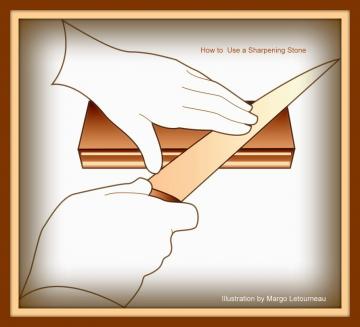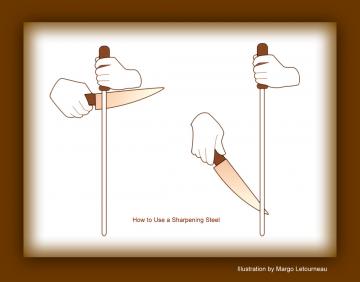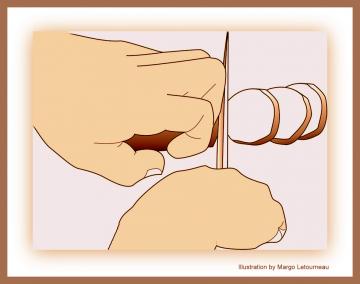If you’ve ever wondered what different types of kitchen knives are for—and how to know which knife to use for what task—you’ve come to the right place! Read on for answers plus tips on how to sharpen your knives and cut food safely.
Which Knife to Use
The Chef’s Knife
As mentioned in “How to Choose The Best Kitchen Knives to Buy,” a chef’s knife is the workhorse of the kitchen, and you can rely on its curved 8”-10” blade to mince, dice, slice, trim, and chop a multitude of vegetables. Cut food with a rocking motion following the line of the blade, or use the tip and adjacent few inches to thin-slice mushrooms, scallions, and cherry tomatoes. Handy as a chef’s knife is, there are times when it’s easier to use one of the specialty knives below.
Utility Knife
A utility knife is smaller than a chef’s knife but larger than a paring knife and, for someone who does only a little cooking, it can serve both functions. A utility knife will generally fit smaller hands quite comfortably.
Paring Knife
Reach for a small paring knife when you need to peel spuds or apples. Unlike a chef’s knife, this isn’t an impact tool so it has only a short bolster. You can find cheap stainless steel paring knives everywhere, but they seldom last more than a year: blades become detached from handles and they can’t be sharpened. Keep a cheap one around for carving pumpkins and other odd projects, but buy a good one for the long haul.
Serrated Bread Knife
Here’s a tool that’s essential for cutting bread and other fine slicing work where a beefier blade might crush or hack up your food. Serrated knives have teeth that are ground into a stainless steel blade. The resulting edge is often razor sharp—great for cutting cleanly through bread or a tomato—but, again, the blade can’t be sharpened, so don’t use it on meat. Anything shorter than a 10” blade is too limiting.
Slicing Knife or Carving Knife
This knife comes in several styles but features a long blade with just a little taper. The blade can be thin and narrow or thick and broad, depending on its intended purpose, and it’s ideal for carving warm meats and poultry.
Boning Knife
You can get along without this knife, but once you have one and work with it you’ll wonder how you ever cooked without it. A boning knife is useful if you fillet your own fish, or for boning roasts and poultry. In the case of fish and poultry, a flexible blade is preferable. For large roasts, a more rigid blade is better. Because flexibility is a virtue in many boning knives, they sometimes don’t have a stabilizing full tang.
How to Sharpen Your Knives
Dull knives are dangerous and, um, pointless. Sharpening gives them new life and should be done regularly. Just how often depends on the quality of your blade and the amount of action it gets. An electric knife sharpener is convenient, but you’ll have more control over what happens to your blade when you use a sharpening stone and sharpening steel.

Using a Knife Sharpening Stone
Sharpening stones are made of abrasive Carborundum or sandstone. Use one periodically to remove steel and reshape the edge of the knife. Place the stone coarse side up on a dampened towel with the stone’s short edge facing you. Rub a spoonful of mineral oil over its surface. Holding the knife blade at a 20-degree angle to the stone with its heel on the stone’s far edge, draw the knife slowly towards you while steadying the blade with the fingertips of your guiding hand. Use gentle, downward pressure; don’t push the blade into the stone.
Make sure that the entire blade, including the tip, passes over the stone’s surface. Repeat five times. Turn the blade over and sharpen the other edge in the same manner; this will probably be easier if you turn the stone so the long edge faces you. Rinse and dry the blade. Repeat on the fine side of the stone if it has one.
Using a Knife Sharpening Steel
Use the sharpening steel almost every day. During regular use, a blade actually folds over on itself, and a sharpening steel unfolds the edge. Hold the steel vertically so the point of the shaft rests on a chopping block. Starting at the heel of the blade, with the blade at a 20-degree angle to the steel, draw the entire cutting edge down along the length of the steel. Exert light pressure on the knife and make sure the point crosses the shaft before ending your stroke. Alternate strokes, five times on each side of the blade.

Knife Cutting Safety Tips
For safety’s sake, always use a sharp knife and never cut toward yourself. Be aware of your cutting hand’s relation to the “guiding hand” that’s steadying the food. For maximum control of a chef’s knife, keep it touching the board by cutting with a rocking motion following the blade’s taper. With fingertips curled under (creating a barrier against the blade), the guiding hand should steady the food then move aside as the rocking blade approaches.

If your food item is too big to “rock through” and requires raising your knife off the board, remove a slice of it to flatten one side, then turn the food flat side down on the board before slicing and dicing the rest.
For what to look for when purchasing knives, see “How to Choose the Best Kitchen Knives to Buy.”












